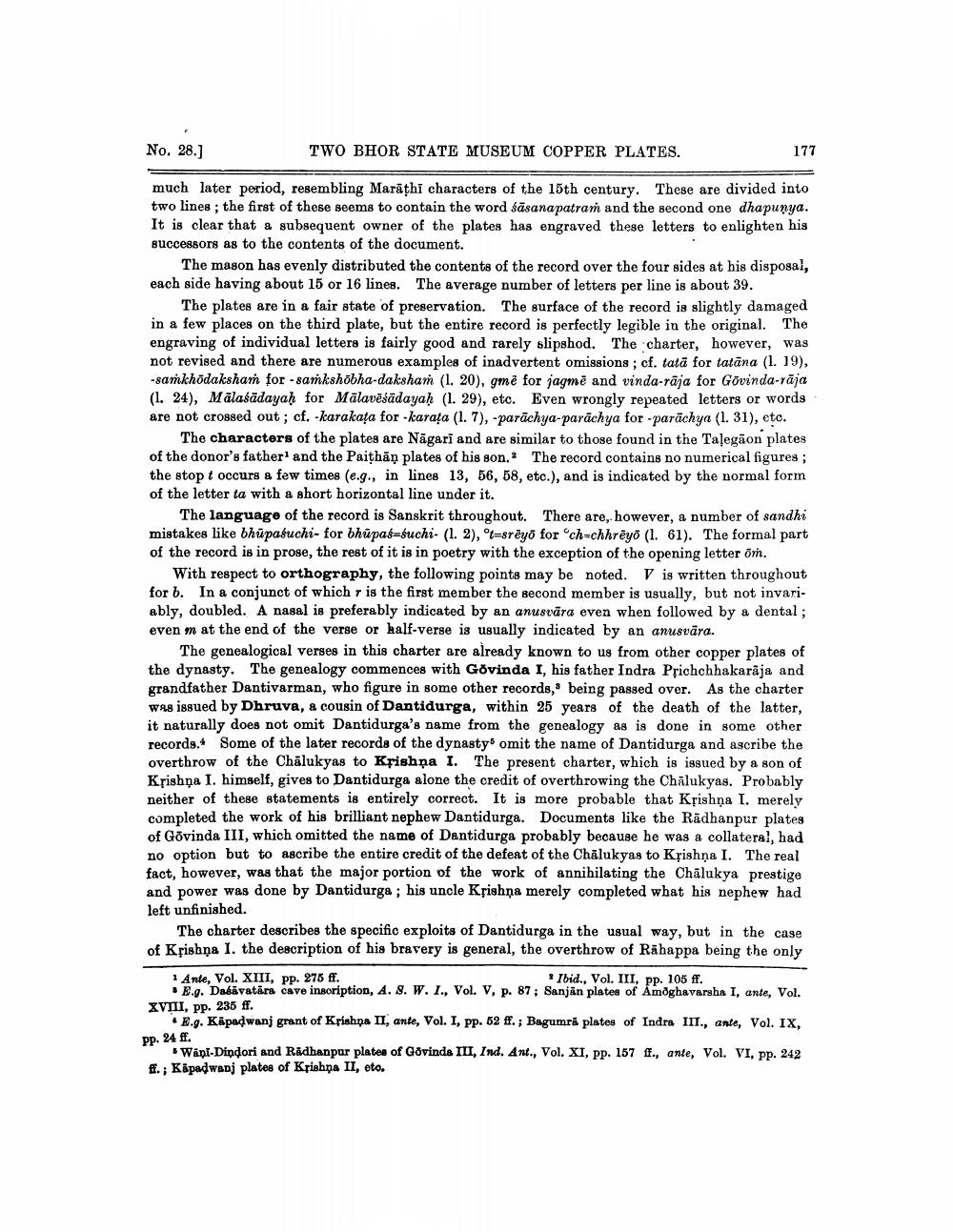________________
No. 28.)
TWO BHOR STATE MUSEUM COPPER PLATES.
177
much later period, resembling Marățhi characters of the 15th century. These are divided into two lines; the first of these seems to contain the word sāsanapatram and the second one dhapunya. It is clear that a subsequent owner of the plates has engraved these letters to enlighten his successors as to the contents of the document.
The mason has evenly distributed the contents of the record over the four sides at his disposal, each side having about 15 or 16 lines. The average number of letters per line is about 39.
The plates are in a fair state of preservation. The surface of the record is slightly damaged in a few places on the third plate, but the entire record is perfectly legible in the original. The engraving of individual letters is fairly good and rarely slipshod. The charter, however, was not revised and there are numerous examples of inadvertent omissions ; cf. tatā for latāna (1. 19), -sankhödaksham for-saṁkshobha-daksham (1. 20), gme for jagme and vinda-rāja for Govinda-rāja (1. 24), Mālašādayah for Mālavēšādayah (1. 29), etc. Even wrongly repeated letters or words are not crossed out; cf. -karakața for-karata (1. 7), -parāchya-parāchya for .parāchya (1. 31), etc.
The characters of the plates are Nāgari and are similar to those found in the Taļegāon plates of the donor's father and the Paithāņ plates of his son. The record contains no numerical figures ; the stop t occurs a few times (e.g., in lines 13, 56, 58, etc.), and is indicated by the normal form of the letter ta with a short horizontal line under it.
The language of the record is Sanskrit throughout. There are, however, a number of sandhi mistakes like bhüpafuchi- for bhūpas=suchi. (1.2), °t=sréyo for "ch-chhreyo (1. 61). The formal part of the record is in prose, the rest of it is in poetry with the exception of the opening letter om.
With respect to orthography, the following points may be noted. V is written throughout for b. In a conjunct of which r is the first member the second member is usually, but not invariably, doubled. A nasal is preferably indicated by an anusvāra even when followed by a dental; even m at the end of the verse or half-verse is usually indicated by an anusvāra.
The genealogical verges in this charter are already known to us from other copper plates of the dynasty. The genealogy commences with Govinda I, his father Indra Prichchhakarāja and grandfather Dantivarman, who figure in some other records, being passed over. As the charter was issued by Dhruva, a cousin of Dantidurga, within 25 years of the death of the latter, it naturally does not omit Dantidurga's name from the genealogy as is done in some other records. Some of the later records of the dynasty omit the name of Dantidurga and ascribe the overthrow of the Chalukyas to Krishňa I. The present charter, which is issued by a son of Krishņa I. himself, gives to Dantidurga alone the credit of overthrowing the Chalukyas. Probably neither of these statements is entirely correct. It is more probable that Kpishņa I. merely completed the work of his brilliant nephew Dantidurga. Documents like the Rädhanpur plates of Govinda III, which omitted the name of Dantidurga probably because he was a collateral, had no option but to ascribe the entire credit of the defeat of the Chalukyas to Krishna I. The real fact, however, was that the major portion of the work of annihilating the Chalukya prestige and power was done by Dantidurga ; his uncle Kšishna merely completed what his nephew had left unfinished.
The charter describes the specific exploits of Dantidurga in the usual way, but in the case of Krishna 1. the description of his bravery is general, the overthrow of Rähappa being the only
1 Ante, Vol. XIII, pp. 275 ff.
Ibid., Vol. III, pp. 105 ff. * E.g. Dabavatara cave insoription, A. 8. W. I., Vol. V, p. 87; Sanjan plates of Amoghavarsha I, ante, Vol. XVIII, pp. 235 ff.
* E.g. Käpadwanj grant of Krishna II, ante, Vol. I, pp. 52 ff.; Bagumri plates of Indra III., ante, Vol. IX,
Pp. 24 ff.
* Wani-Dindori and Rādhanpur plates of Govinda III, Ind. Ant., Vol. XI, pp. 157 f., ante, Vol. VI, pp. 242 ff.; Käpadwanj plates of Krishna II, eto.




